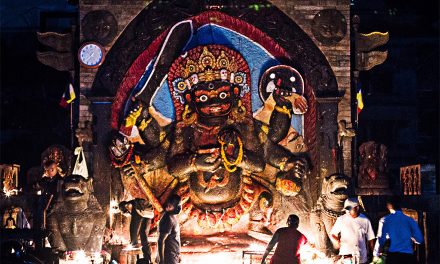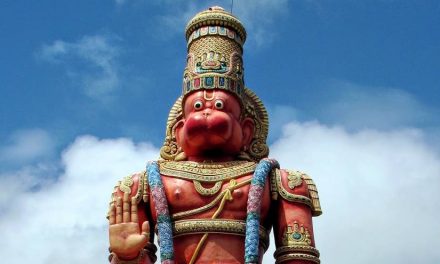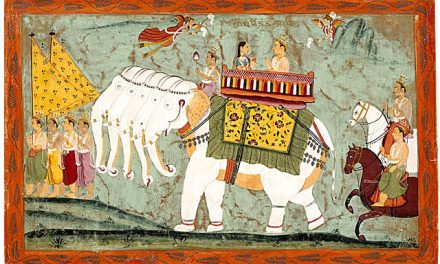The Supreme Goddess (Devi) is worshipped in many forms. She is variously named according to her imagined age; sometimes, she is named in recognition of her heroic achievements of having destroyed the Mahisasura. According to Markendeya Purana, the Devi is described as Durga and in this form Devi destroyed the Asura.
Durga, one of the most eminent of the goddesses of the Hindu Pantheon, emerged as a formidable warrior deity to protect the universe from the destructive power of the demons. Her popularity as Mahadevi or Mahasuri (great goddess) never receded even after the lapse of thousands of years. In the course of her rise of to a pre-eminent position, Durga multiplied her manifestations for specific purposes, thus earning on abiding popularity.
The abundant archaeological remains and loose sculptures of different periods spread throughout the country, numerous stories highlighting her pastime exploits and miraculous power. Her profuse representation in the arts and her emergence from combined energies of the demigods (according to the Puranic accounts) bespeak her hoary antiquity and wide celebrity as the world mother.
The origin of Durga is mysterious. Some scholars have traced her origin to the pre-Vedic period. According to scholars, in the primitive societies, the entire culture centered round the mother, who was the symbol of generation and actual producer of life. In the social evolution, maternity was held in high esteem, the mother being the control figure of religion.
In the view of J.Marshall who excavated the Indus valley sites, the Sakti cult evolved in India out of the so-called mother. The goddess cult, closely associated with the cult of the so-called proto-Siva and Sakti, the dual deities, were the principal deities of the non-Aryan people of the Indus civilization. From the Vedic period onwards, ample references are found about the goddess Durga in various forms. The name Durga finds mentioned in the Taittiriya Aranyaka, and in the Khilaratri Sukta, Durga is stated to have three important manifestations: Mahalaxmi, Mahasaraswati, and Mahakali. [Durga is an expansion of Radharani’s internal potency, and like Radharani, she is Yogamaya.]
In the Upanishads, the concept of Brahman is associated with that of Sakti, the feminine personification of the universal life force. It is believed that this cult gained preeminence during the Gupta period. The popularity of this understanding can be assessed from the fact that it had its impact felt throughout the country, where Devi was found represented profusely. In the Indian ‘plastic art’ she became more lively and widely spread. With Tantricism gaining popularity during the medieval times and thereafter, she came to be adorned as one of the principal Tantric deities and a number of Tantric rituals were added to her worship.
Sakti-devi embodied in her the integral character as mother goddess, and was known by various names like Maha Durga, Mahalaxmi, Mahakali, Kali, Katyayani, Chandika, Chamunda, Kausiki, Satakshi, Sakambari, Bindhyabasini, Mahagouri, and Mahamaya.
The story of Durga’s combat with the asura Mahisa, resulting in the asura’s final annihilation, was recorded in several texts, further popularizing this mythic event by giving a variety of names to the Mahadevi. The Matsya Purana, varaha Purana, Devi Bhagavati Purana, Skanda Purana, Kalika Purana, Padma Purana, etc. all recorded the story by interpolating interesting anecdotes, thus further highlighting the greatness of Mahadevi. She was given numerous names by different Puranas so that in course of time, the nomenclature of Durga became associated with one hundred eight major and as many as a thousand minor Pithas.
The authors of the Devi Mahatmya highlighted the might and supremacy of Durga. According to the description contained in Kenopanisad, the great goddess manifested herself to a host of demigods, thus illustrating her potency in comparison to them.
The Sakta Upanisad enhanced the status of Devi in philosophical grab. The Devi Upanisad relates the personifications of Shakti Durga as Mahalaxmi, Saraswati and Vaishnavi as Brahma Swarupini. Durga is here depicted as a Mahavidya, Viswarupini effulgent like the Morning Sun, relieving her devotees from the pains of worldly existence with all their desires.
In the Mahabharat, the name Durga is mentioned along with the names of different goddesses in a hymn addressed by Arjuna in the form of a prayer to the goddess Kumari, Kali, Kapali, Bhadra Kali, Kandi, Kanda, Tarini, Katyayani, Durga etc. depicted as adorned with jewels and different weapons. Yudhisthir’s invocation to goddess Durga gives a clear picture of her as the war goddess, the killer of Mahisasura (the buffalo demon). Here she is depicted as four-faced, four-armed, and holding a noose, bow, arrow and disk in her hands.
In the epics, Durga is said to be worshipped by the Savaras, Barbers and Pulindas (aboriginal tribes possibly belonging to the Austro-Asiatic ethnic stock that inhabited middle India in ancient times). Durga was raised to the highest position in the Pantheon by the Puranas. The ‘Devi Mahatmya’ section of the Markandeya Purana (which is described by some as a non-sectarian Purana) conceives Mahisamardini Durga as a full-fledged warrior goddess in the form of Candi and Chandika. Effulgently emerging from the gods, her countenance dazzling like thousands of suns, she pervaded the three worlds and seven seas forcing the gods themselves to bow down as a mark of respect to the all powerful goddess. Fully equipped, she engaged the demons and their leaders in terrific battles, vanquished them and finally overpowered the Asura Mahisa, piercing his body with the trident when the demon came out of the carcass of the buffalo. So goddess Durga became Mahisamardhini.
Durga Ma embodies in her the integral character of mother goddess and was known by various names like Kalyani, Chandika, Kali, Chamunda, Kousiki, Satakshi, Sakambari, Mahisamardini, Vindhyavasini, Mahalaxmi, Mahakali, and MahaDurga.
Different inscriptions from the 5th – 6th century of the Christian era up to 13th century A.D. speak the prevalence of mother worship in different places of Orissa. Copper plates from Kanas and Olasing in Puri district reveal the existence of a popular mother cult in Tosali during the 6th-7th century A.D. It is interesting to note that in both the copper plates, one of the donees is a deity — Maninagesavara Bhattaraka.
From the above study it is concluded that Durga’s importance never diminished and has ever been growing on the Indian religious scene. She declared that she would come for protection of her devotees whenever there is an uprising of the Asuras. Thus:
Ittham yada yada badha danovathabhavishyati
Tada tado vatriyaham karishami cerisan khyayam














Very informative article, all the Purnas mentioned with Her description help the mind grasp her form which is beyond grasp. She existed in the supernatural minds of the Puranas author to reveal her form.